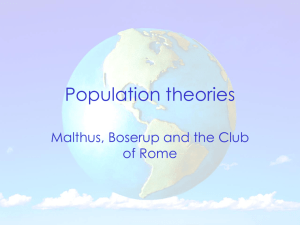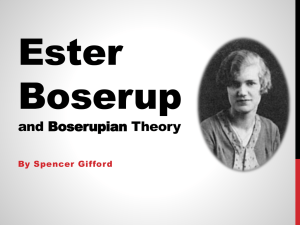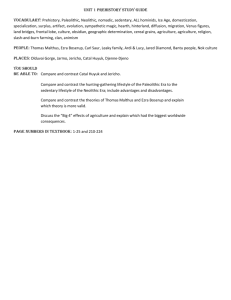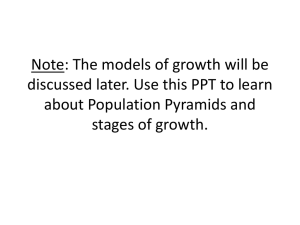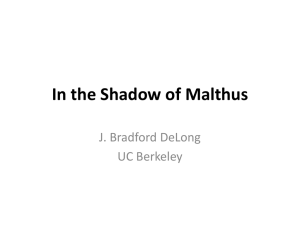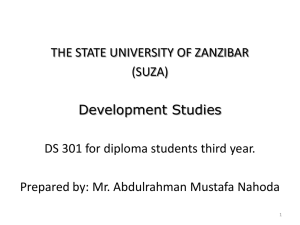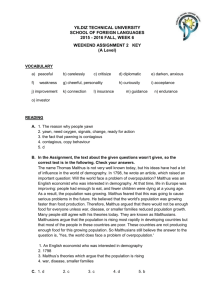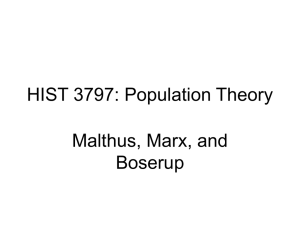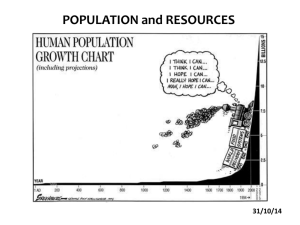Population theories - BC Learning Network
advertisement
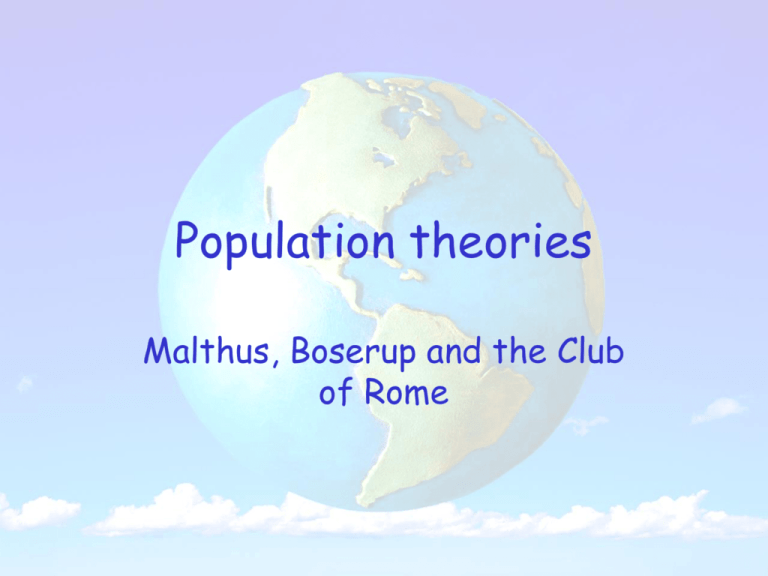
Population theories Malthus, Boserup and the Club of Rome Thomas Malthus • 1766-1834. Born near Guildford! • Wrote ‘An essay in the First Principle of population’ first published in 1798 • Debatable whether the principles of Malthus two hundred years ago (that were very revolutionary and controversial) have any relevance to the modern world. • The world population in 1798 was at nine million people. We have now passed the six billion mark. The Core Principles of Malthus: ¤ Food is necessary for human existence ¤ Human population tends to grow faster than the power in the earth to produce subsistence ¤ The effects of these two unequal powers must be kept equal ¤ Since humans tend not to limit their population size voluntarily - “preventive checks” in Malthus’ terminology. Malthus recognised that population if unchecked, grows at a geometric rate: 1 2 4 8 16 32 However, food only increases at an arithmetic rate, as land is finite. 1 2 3 4 5 6 and therefore he said…. Malthusian Catastrophe food population TIME War, famine, disease. CHECKS Malthus suggested that once this ceiling (catastrophe) had been reached, further growth in population would be prevented by negative and positive checks. He saw the checks as a natural method of population control. They can be split up into 3 groups…. Negative checks (decreased birth rate)…. Negative Checks were used to limit the population growth. It included abstinence/ postponement of marriage which lowered the fertility rate. • Malthus favoured moral restraint (including late marriage and sexual abstinence) as a check on population growth. However, it is worth noting that Malthus proposed this only for the working and poor classes! Positive checks (increased death rate) • Positive Checks were ways to reduce population size by events such as famine, disease, war - increasing the mortality rate and reducing life expectancy. 'J' Curve - Population Crash Model Was Malthus right? • There has been a population explosion • Africa – repeated famines, wars, food crisis, environmental degradation, soil erosion, crop failure and disastrous floods – so was he right? But….. • Technological improvements which he could not have foreseen • The increased amount of cropland due to irrigation • Reduced population growth as countries move through the DTM The Club of Rome • Group of industrialists, scientists, economists and statesmen from 10 countries • Published ‘The Limits to Growth’ in 1972 The Club of Rome – basic conclusion…. • If present growth trends in world population continue and if associated industrialisation, pollution, food production and resource depletion continue unchanged, the limits to growth on this planet will be reached sometime in the next 100 years. • The most probably result will be sudden and uncontrollable decline in both population and industrial capacity Is the Club of Rome right? • Don’t panic yet! • Doesn’t take human dimension sufficiently into account • Human race is adaptable and innovative • Human responses have changed – e.g. alternative sources of fuel (to replace fossil fuels), HYVs seeds to prevent starvation in parts of Asia Esther Boserup 1965 • Boserup believed that people have the resources of knowledge and technology to increase food supplies. • Opposite to Malthus – she suggested that population growth has enabled agricultural development to occur • Assumes people knew of the techniques required by more intensive systems and used them when the population grew. i.e….. • Demographic pressure (population density) promotes innovation and higher productivity in use of land (irrigation, weeding, crop intensification, better seeds) and labour (tools, better techniques). Was she right? Boserup argued that the changes in technology allow for improved crop strains and increased yields. • GM crops • ‘Green revolution’ But…. • Boserup admits overpopulation can lead to unsuitable farming practices which may degrade the land • e.g. population pressure as one of the reasons for desertification in the Sahal region (so fragile environments at risk) • Boserup’s theory based on assumption of ‘closed’ society -not the case in reality (migration)
